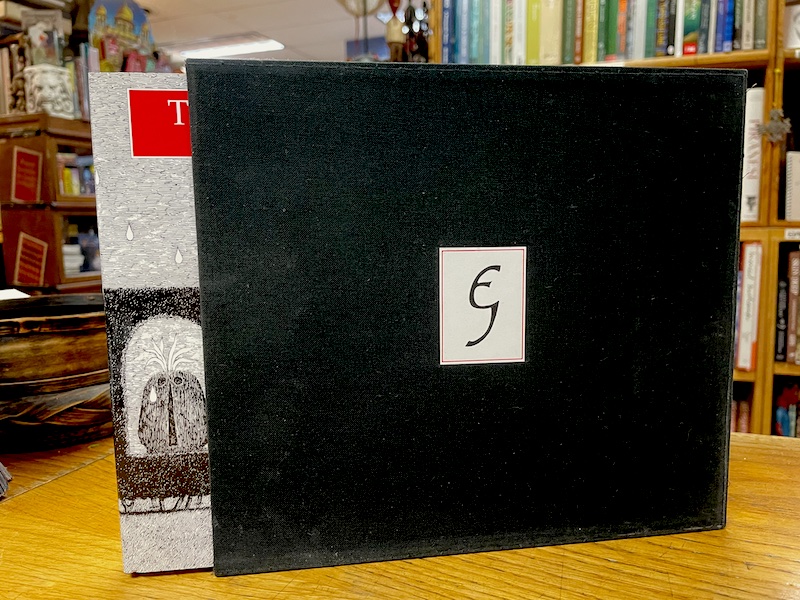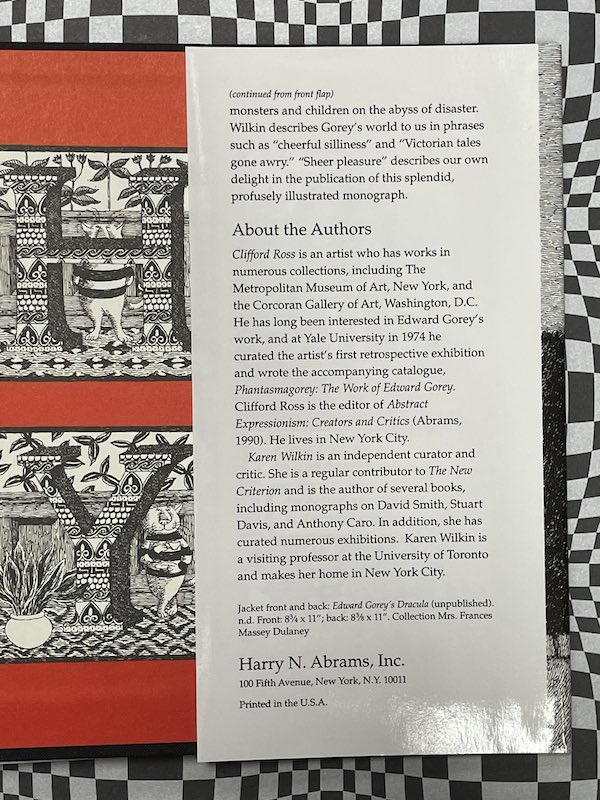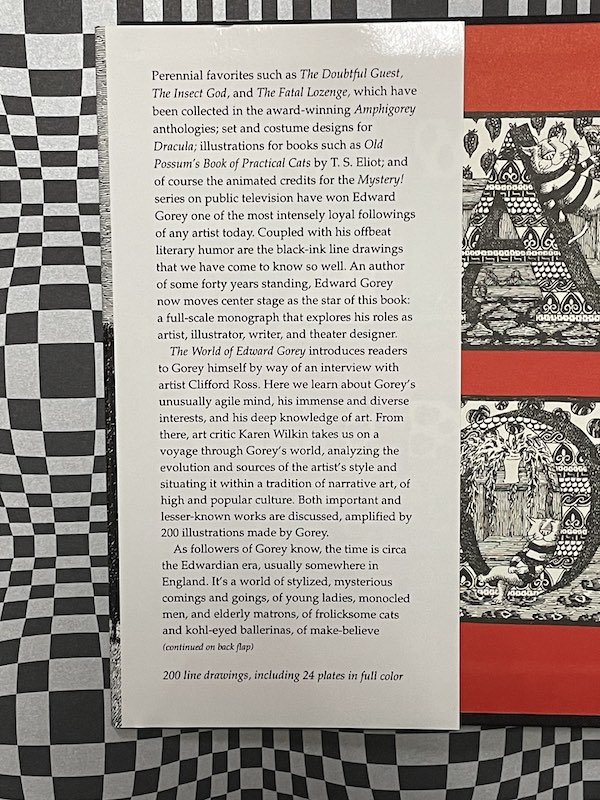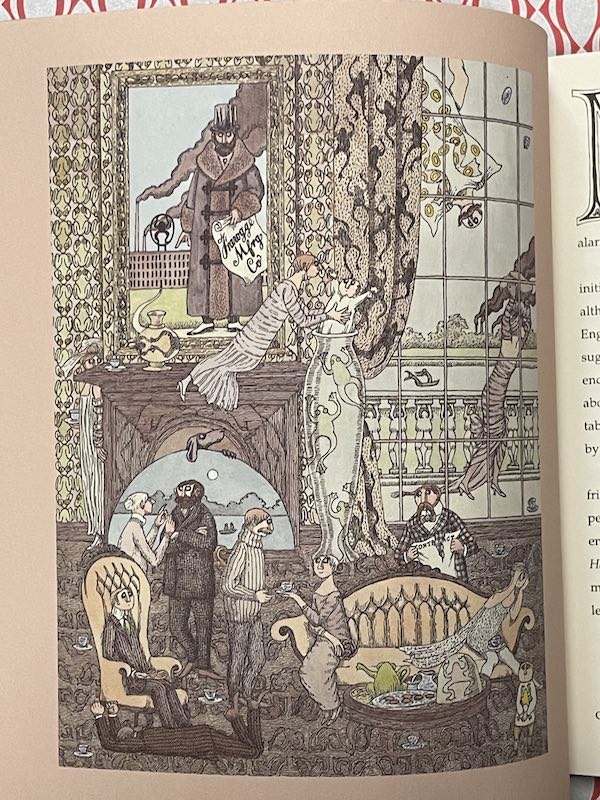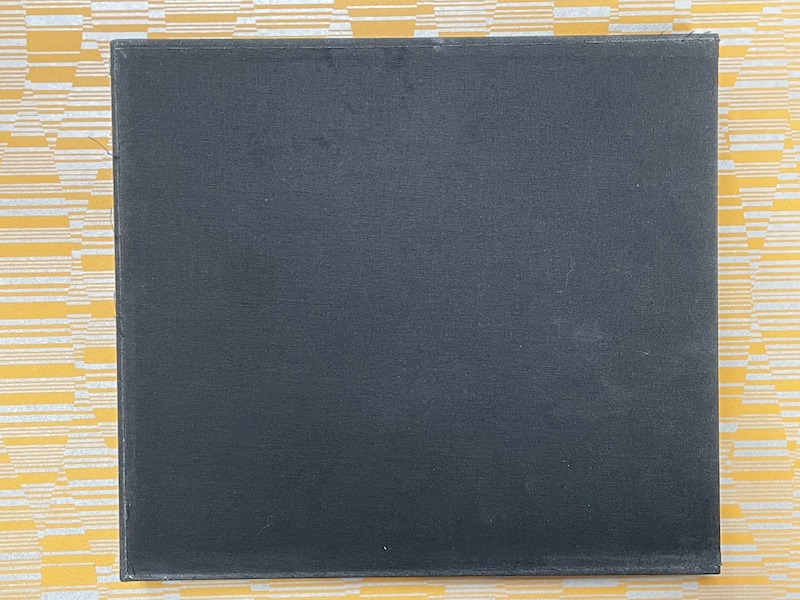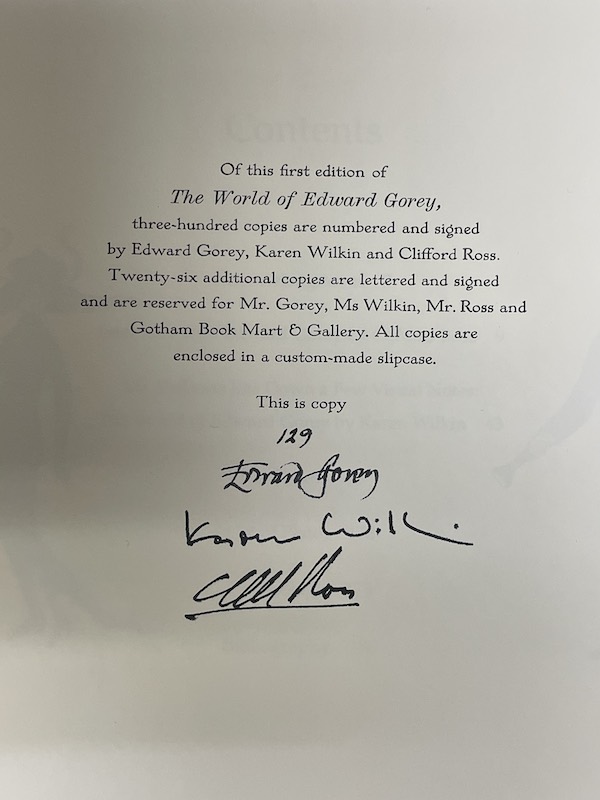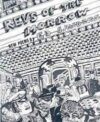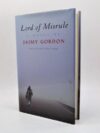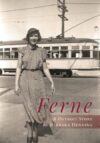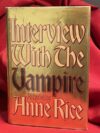The World of Edward Gorey (signed, limited edition)
Signed, limited and numbered edition 1/300 in slipcase, VERY FINE as new in fine slipcase with light shelf wear, (see photos) signed and numbered by the artist Edward Gorey and the editiors (see photos for detail). ABRAMS, 1996
To look at an Edward Gorey drawing is to cross into a turn-of-the-century twilight zone, a faded black-and-gray realm where bats–or possibly umbrellas–swoop above the shrubbery, buildings appear as attractive and sturdily built as the House of Usher, and everything feels autumnal, crepuscular, rainswept and more than a little menacing.
In Gorey country, ancestral manors, like the stately homes glimpsed in opening titles for the PBS series Mystery!, are usually inhabited by languid, swooning flappers and mustachioed Edwardian gentlemen with a taste for brocaded dressing gowns or heavy fur coats. That introductory sequence for Mystery! is probably the artist-illustrator’s most recognizable work. He also has, of course, delighted many a New Yorker reader with his macabre cartoons. Furniture runs to divans, large urns, gazebos and allegorical garden sculpture, such as the oft-admired “statue of Corrupted Endeavor.” Down the lonely hallways one may, from time to time, glimpse a newt-like beast or a poltergeist or possibly a dogged policeman on the trail of a murderess. For the most part, everyone strikes poses, like the more histrionic characters in one of the gloomier plays of Chekhov.
City life is no better, and can in fact prove far more vicious. An opera fan named Jasper Ankle grows increasingly insane, dispensing with the rivals and lovers of his favorite diva. A very disturbed couple, with a particularly sanguinary hobby, meet “at a Self-Help Institute lecture on the Evils of the Decimal System.”
“Beware of this and that,” warns a droopy raven in The Epiplectic Bicycle. And admirers of Gorey’s little albums, gathered in three omnibus volumes (Amphigorey, Amphigorey Too and Amphigorey Also), know that his pictures suggest, like episodes from a fin de siècle version of The X-Files, that “much more is happening out there than we are aware of.”
It is, for instance, no surprise that Gorey’s favorite reading should fall under the category he calls the “sinister cozy.” In his interview with Clifford Ross (the first part of The World of Edward Gorey) the artist admits to having devoured all of Agatha Christie’s mysteries at least five times. He is also a devotee of Fantomas–the fictional master criminal in the novels by Marcel Allain and Pierre Souvestre–who once replaced the perfume in a department store’s atomizers with sulfuric acid. And Gorey’s The Loathesome Couple is even dedicated to W. N. Roughead, revered for his elegantly witty accounts of domestic murder. The tone of many Gorey booklets–especially the alphabets and limerick collections–often recalls the jaunty black humor of Hilaire Belloc’s Cautionary Tales.
Nearly everyone, including Karen Wilkin in her extended essay in The World of Edward Gorey, speaks admiringly of the artist’s meticulous crosshatching and melodramatic, gothicky vision. (Gorey, of course, maintains that he merely depicts the random vicissitudes of ordinary life.) Not enough praise, however, has been awarded to Gorey’s superb prose: he possesses the ear of a great parodist, and indeed virtually all his albums are pastiches of some previous genre, from the classic mystery (The Awdrey-Gore Legacy) to Victorian melodrama (The Green Beads) and Winnie-the-Pooh (The Untitled Book). The perfectly balanced periodic sentences owe something to the laconic campiness of Ronald Firbank and to the affectless dialogue and humor of Ivy Compton-Burnett. At the beginning of one Compton-Burnett novel, The Present and the Past, a group of children watch a sick chicken being pecked to death. Gorey opens The Loathsome Couple with a comparable scene: “Harold Snedleigh was found beating a sick small animal to death with a rock when he was five years old.”
Perhaps this master’s greatest set of parodies (on a par with Gorey’s The Unstrung Harp, The Willowdale Handcar and The Blue Aspic) is the collection of “cycling cards” that make up The Broken Spoke. The postcards, each of which pictures a bicycle, imitate primitive cave art, William Blake watercolors, religious paintings, French posters, the exploits of Victorian explorers and even Gorey himself. The captions are as delicious as the artwork: “Bicycle worship in the Tedila Archipelago”; “Innocence, on the Bicycle of Propriety, carrying the Urn of Reputation safely over the Abyss of Indiscretion.”
In The Unstrung Harp the novelist, Mr. Earbrass, goes to a literary party. “The talk deals with disappointing sales, inadequate publicity, worse than inadequate royalties, idiotic or criminal reviews, others’ declining talent, and the unspeakable horror of the literary life.” Perhaps this last explains Edward Gorey’s own retirement to Massachusetts. Indeed, along with the book’s 200 line drawings and 24 color plates, the best part of The World of Edward Gorey may be the photographs of the artist’s dilapidated, book-strewn house on Cape Cod. Though Ross’ interview and Wilkin’s essay are both illuminating, the real Goreyphile yearns for even more detailed biographical information–about Gorey’s nearly 30 years of faithful attendance at all the performances of the New York City Ballet, about his work as a cover artist for Anchor paperbacks, about precisely how he creates his distinctive artwork. Doubtless other books will be written about the irresistible Edward Gorey. After all, only a few other comic imaginations–P.G. Wodehouse and Garrison Keillor come to mind–have created worlds at once so utterly familiar and yet so completely original.
Michael Dirda, from Smithsonian Magazine
$ 350.00
Out of stock

